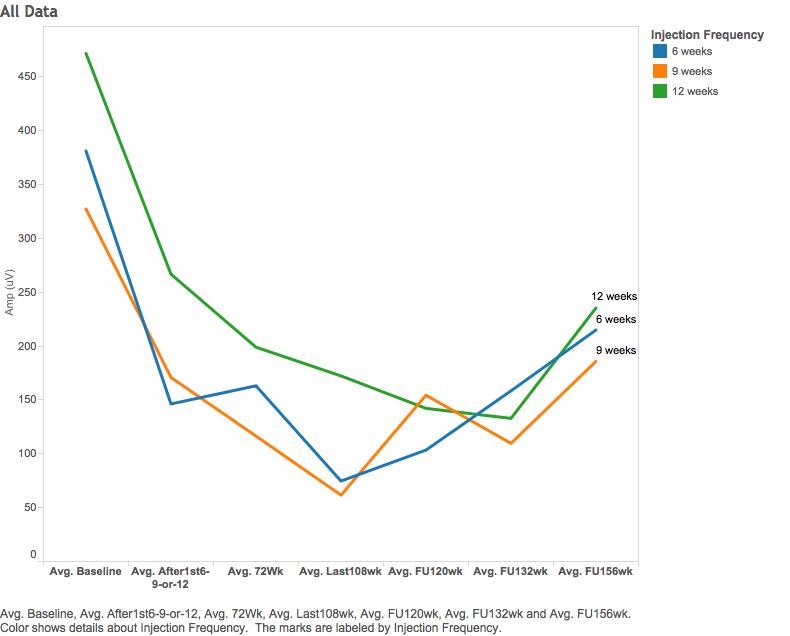Back to 2016 Annual Meeting
Effect of Botulinum Toxin Injection Intervals on the Irreversibility of Targeted Muscle Paralysis: An Electromyographic Study.
Thanapoom Boonipat, BS, Jeffrey A. Cohen, MD, Mitchell Stotland, MD.
Geisel School of Medicine at Dartmouth, Hanover, NH, USA.
Background:
Botulinum toxin (BT) has a multitude of clinical uses. An important drawback, however, is its short-lived action and the corresponding requirement for a schedule of re-injection in order to maintain therapeutic effect1. This results in significant cost and patient inconvenience. Anecdotal reports suggesting that repeated use of BT prolongs its effect have not been substantiated by scientific examination. Clinical models of peripheral nerve transection demonstrate irreversible denervation and muscle atrophy if nerve repair and recovery does not occur prior to 12-24 months2-4.
Purpose:
To investigate, using electromyographic (EMG) analysis and clinical assessment, whether repeated, short-interval injection of BT over a prolonged period of time will yield irreversible targeted glabellar muscle paralysis.
Methods:
Study participants (19 Caucasian females, 38-59 yrs) presented with at least moderate glabellar lines at maximum frown, determined by the “Photonumeric Guide to Assessing Glabellar Line Severity” (Allergan Inc.).
Subjects were randomly assigned to receive treatment either q6 weeks (Group I), q9 weeks (Group II), or q12 weeks (group III).
Treatment consisted of five injections of BT (20U total) administered to the glabellar muscles.
Study duration: 3 years (treatment phase 0-108 weeks; follow-up phase 108-156 weeks).
Paired sample t-testing was used to determine significance of difference (p<0.05) between groups.
Outcomes Measured:
Serial (EMG) studies of corrugator muscle were performed prior to the first and second injection, at week 72, week 108, and during the post-treatment follow-up phase at weeks 120, 132, and 156.
Repose and maximum frown photographs were obtained at all visits.
Results:
Compared to baseline, the 3 treatment groups demonstrated significant reduction in corrugator EMG activity at all study timepoints, particularly so for the q6 and q9 week groups (p<0.05). Moreover, while a modest recovery trend was noted both electromyographically and clinically, EMG recovery during the 48-week post-treatment phase was not found to be statistically significant.
Conclusions:
By conducting a 3-year study, including 2 years of short-interval targeted BT injections and 1.1 year of EMG follow-up, we have demonstrated a meaningful reduction in muscle activity that tended to persist over the 1-year follow-up period. Further investigation with larger sample size and longer follow-up assessment is warranted.
References:
1. Flynn TC. (2010) Botulinum toxin: examining duration of effect in facial aesthetic applications. American J. Dermatol. 11(3):183-99
2. Fu, S.Y. and Gordon, T. (1995) Contributing Factors to Poor Functional Recovery after Delayed Nerve Repair: Prolonged Axotomy. The Journal of Neuroscience, 15(5): 3876-3885
3. Aydin, M. A., et al. (2004) Force Deficits in Skeletal Muscle after Delayed Reinnervation Plast. Reconstr. Surg. 113: 1712
4. Cederna, P.S., et al. (2000) Skeletal Muscle Reinnervation by Reduced Axonal Numbers Results in Whole Muscle Force Deficits. Plast. Reconstr. Surg. 105: 2003 
Back to 2016 Annual Meeting
|
